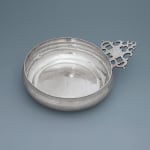

Edward Gladwin
A Charles II Antique English Silver Bleeding Bowl, 1674
Length: 5.38 in.
Weight: 8 oz. 6 dwt.
London
V9746
$ 16,500.00
Provenance: How of Edinburgh, London, January 1990; Jackson records a cup, two tankards, and an alms dish by this maker between 1670 and 1680. This model handle with slight variation...
Provenance:
How of Edinburgh, London, January 1990;
Jackson records a cup, two tankards, and an alms dish by this maker between 1670 and 1680. This model handle with slight variation in piercing was used by silversmiths in Boston. A porringer with similar handle by John Coney from the Collection of Mrs. Herman F. Clarke is illustrated in Herman Frederick Clarke, “John Coney Silversmith”, p. 53, pl. xxiii, another by Jeremiah Dummer is at the Boston Museum of Fine Arts, Buhler, cat. no. 18, p. 21. The porringer of this form became more popular in the Colonies than in England.
David M. Mitchell cites Anthony Sale's attribution of this mark to Edward Gladwin in “Silversmiths in Elizabethan and Stuart London”, p. 281.
How of Edinburgh, London, January 1990;
Jackson records a cup, two tankards, and an alms dish by this maker between 1670 and 1680. This model handle with slight variation in piercing was used by silversmiths in Boston. A porringer with similar handle by John Coney from the Collection of Mrs. Herman F. Clarke is illustrated in Herman Frederick Clarke, “John Coney Silversmith”, p. 53, pl. xxiii, another by Jeremiah Dummer is at the Boston Museum of Fine Arts, Buhler, cat. no. 18, p. 21. The porringer of this form became more popular in the Colonies than in England.
David M. Mitchell cites Anthony Sale's attribution of this mark to Edward Gladwin in “Silversmiths in Elizabethan and Stuart London”, p. 281.

